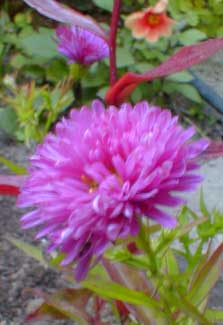
'Patricia Ballard' Autumn Aster;
or, Michaelmas Daisy
"Autumn fills her lap with asters."
-Madison Cawein
(1865-1914)
(1865-1914)
A garden standard for half a century 'Patricia Ballard' Autumn aster has semi-double pink or pale lavender-pink flowers with yellow eye, in bloom by September. It is suitable for zones 4 through 8, in the perennial border, cutting garden, or butterfly garden.
Cultivars of Aster novi-belgii, the New York or Autumn Aster or Michaelmas Daisy, are among the most colorful & important border perennials for late in the year. 'Patricia Ballard' will continue flowering until late autumn or when a good hard frost hits it, when it will begin to die back & at that time, for tidiness sake, it can be clipped to near the ground.
Autumn asters require full sun & good air circulation, or they can be afflicted with powdery mildew by about mid-summer. Regular watering, but never soggy, helps keep mildew at bay, whereas stressing with droughtiness or bogginess will increase susceptibility.
It should perhaps not be a companion plant with beebalms or phloxes which share susceptibility to mildew. In gardens prone to mildew, dilute sprays of milk (1:5 ratio) is the most effective preventative, periodically spraying susceptible plants by the start of summer so that mildew never gets started. Once mildew afflicts leaves nothing will reverse it so a plant might as well but cut to the ground, mildewed leaves discarded rather than composted, the clump allowed to start over.
Many autumn aster varieties named for the Ballard family, including Ada, Guy, Freda, Hilda, Marie, Sarah & Ernest Ballard, this last being the British plant breeder who enjoyed honoring all his kin with his aster creations. Ernest bred his Michaelmas Daisy varieties early in the 20th Century at Old Court Nursery in Worcestershire, founded in 1906, & even today a world leader in development & production of autumn flowering asters.
Old Court Nurseries also maintains Ernest's original garden now called Picton Garden, designated a National Heritage Collection. It is open to the public from August to late September when the autumn asters & other late-blooming perennials are in their glory.